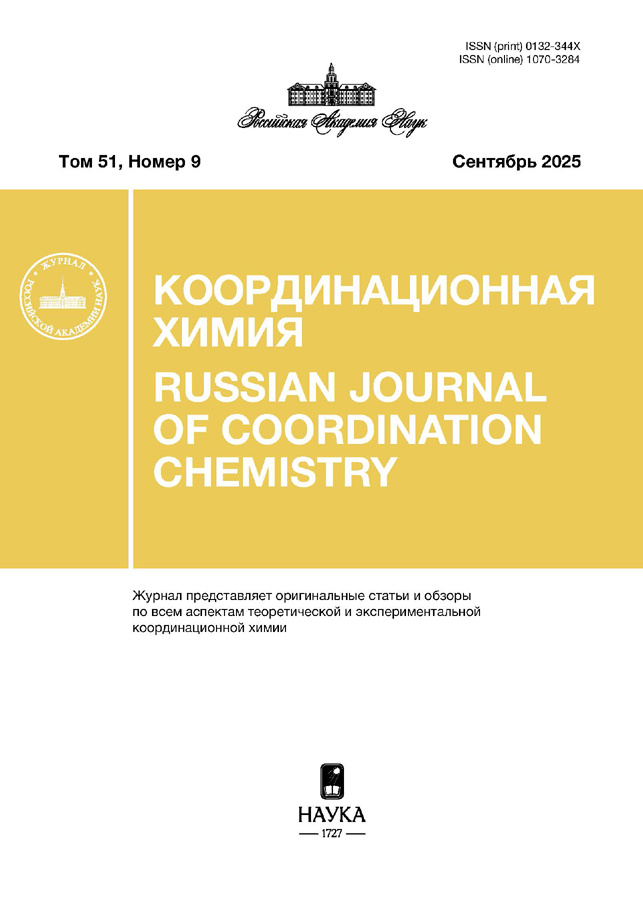Особенности синтеза 1,3-иминофосфина с 2,1,3-бензотиадиазольным заместителем и комплекса Pt с ним
- Авторы: Хисамов Р.М.1, Конченко С.Н.1, Сухих Т.С.1
-
Учреждения:
- Институт неорганической химии им. А.В. Николаева СО РАН
- Выпуск: Том 50, № 10 (2024)
- Страницы: 679-692
- Раздел: Статьи
- URL: https://cardiosomatics.ru/0132-344X/article/view/667656
- DOI: https://doi.org/10.31857/S0132344X24100059
- EDN: https://elibrary.ru/LPQBRV
- ID: 667656
Цитировать
Полный текст
Аннотация
При попытке осуществить синтез нового иминометилфосфина tBuC(Ph2P)=N-Btd (Btd = 2,1,3-бензотиадиазол) по трехстадийной схеме: 1) NH2-Btd + tBuC(=O)Cl → tBuC(=O)NH-Btd; 2) tBuC(=O)NH-Btd + SOCl2 → tBuC(Cl)=N-Btd; 3) tBuC(Cl)=N-Btd + Ph2PSiMe3 → tBuC(Ph2P)=N-Btd было обнаружено, что на второй стадии происходит хлорирование карбоцикла бензотиадиазольного фрагмента. Взаимодействие образующегося при этом имидоилхлорида tBuC(Cl)=N-(7-Cl-Btd) с Ph2PSiMe3 приводит к 1,3-иминометилфосфину tBuC(Ph2P)=N-(7-Cl-Btd) (PC=N). Побочными продуктами на этой стадии являются 1,3-аминометилфосфиноксид tBuC{Ph2P(O)}NH-(7-Cl-Btd) (POCN) и (Ph2POx)2, образующиеся в результате частичного окисления и гидролиза. Изучены реакции PC=N и POCN с [Pt(COD)Cl2] (COD = 1.3-циклооктадиен). В случае PC=N реакция приводит к комплексу [Pt(PC=N)2Cl2]. Во втором случае происходит разрыв связи P–C в POCN, из реакционной смеси выделены [PtCl2(Ph2POH)2](POCN) и [Pt(CH3CN){tBuC-NH-(7-Cl-Btd)}Cl]. Строение новых соединений установлено с помощью монокристального РСА (CCDC № 2335150 (tBuC(Cl) N-(7-Cl-Btd)), 2335152 (POCN · Et2O), 2335149 (Ph2POx)2, 2335153 ([Pt(PC=N)2Cl2]), 2335154 ([PtCl2(Ph2POH)2](POCN)), 2335151 ([Pt(CH3CN)(tBuC-NH-(7-Cl-Вbtd))Cl]).
Ключевые слова
Полный текст
Об авторах
Р. М. Хисамов
Институт неорганической химии им. А.В. Николаева СО РАН
Email: sukhikh@niic.nsc.ru
Россия, Новосибирск
С. Н. Конченко
Институт неорганической химии им. А.В. Николаева СО РАН
Email: sukhikh@niic.nsc.ru
Россия, Новосибирск
Т. С. Сухих
Институт неорганической химии им. А.В. Николаева СО РАН
Автор, ответственный за переписку.
Email: sukhikh@niic.nsc.ru
Россия, Новосибирск
Список литературы
- Bálint E., Tajti Á., Tripolszky A., Keglevich G. // Dalton Trans. 2018. V. 47. P. 4755.
- Smith M.B. // Molecules. 2022. V. 27. P. 6293.
- Sukhikh T.S., Khisamov R.M., Konchenko S.N. // Symmetry. 2023. V. 15. P. 157.
- Khisamov R.M., Sukhikh T.S., Konchenko S.N., Pushkarevsky N.A. // Inorganics. 2022. V. 10. P. 263.
- Khisamov R.M., Ryadun A.A., Konchenko S.N., Sukhikh T.S. // Molecules. 2022. V. 27. P. 8162.
- Baranov A.Y., Sukhikh T.S., Artem′ev A.V. // J. Struct. Chem. 2022. V. 63. P. 658.
- Rogovoy M.I., Bagryanskaya I.Y., Sadykov E.H. // J. Struct. Chem. 2023. V. 64. P. 1654.
- Rong M.K., Holtrop F., Slootweg J.C., Lammertsma K. // Coord. Chem. Rev. 2019. V. 380. P. 1.
- Huber T., Bauer J.O. // Chem. Eur. J. 2023. P. e202303760.
- Farkas G., Császár Z., Tóth-Farsang E. et al. // J. Organomet. Chem. 2023. V. 994. P. 122723.
- Liu R., Liu Y., Yang W., Li X., Feng L. // ACS Omega. 2023. V. 8. P. 18290.
- Reis Conceição N., Mahmoud A.G., Guedes da Silva M.F.C. et al. // Mol. Catal. 2023. V. 549. P. 113512.
- Radcliffe J.E., Batsanov A.S., Smith D.M., Scott J.A. et al. // ACS Catalysis. 2015. V. 5. P. 7095.
- van Dijk T., Burck S., Rong M.K. et al. // Angew. Chem. Int. Ed. 2014. V. 53. P. 9068.
- Rong M.K., van Duin K., van Dijk T. et al. // Organometallics. 2017. V. 36. P. 1079.
- Kandel R., Huynh K., Dalgliesh L. et al. // Inorg. Chim. Acta. 2016. V. 445. P. 117.
- Lee K.-F., Yang T., Tsang L.-Y. et al. // Organometallics. 2021. V. 40. P. 358.
- Kandel R., Schatte G., Jessop P.G. // Dalton Trans. 2019. V. 48. P. 12512.
- Fischer M., Steinert H., Schmidtmann M., Beckhaus R. // Dalton Trans. 2019. V. 48. P. 1936.
- Sheldrick G. // Acta Crystallogr. A. 2015. V. 71. P. 3.
- Sheldrick G. // Acta Crystallogr. 2015. V. 71. P. 3.
- Dolomanov O.V., Bourhis L.J., Gildea R.J. et al. // J. Appl. Crystallogr. 2009. V. 42. P. 339.
- Alexeev A.V., Gromilov S.A. // J. Struct. Chem. 2010. V. 51. P. 156.
- Alexeev A.V., Gromilov S.A. // J. Struct. Chem. 2010. V. 51. P. 744.
- Prescher C., Prakapenka V.B. // High Pressure Res. 2015. V. 35. P. 223.
- Afonin M.Y., Martynenko P.A., Kolybalov D.S. // Inorg. Chem. 2024. V. 63. P. 369.
- Sukhikh T.S., Kolybalov D.S., Khisamov R.M., Konchenko S.N. // J. Struct. Chem. 2022. V. 63. P. 1446.
- Nieger M., Schinkels B., Niecke E. // Experimental Crystal Structure Determination. CCDC 174103. 2002. https://doi.org/10.5517/cc5v57d.
- Dashti-Mommertz A., Neumüller B. // Z. Anorg. Allg. Chem. 1999. V. 625. P. 954.
- Tam E.C.Y., Maynard N.A., Apperley D.C. // Inorg. Chem. 2012. V. 51. P. 9403.
- Khisamov R.M., Konchenko S.N., Sukhikh T.S. // J. Struct. Chem. 2022. V. 63. P. 2113.
- Hu C., Wang M., Han X., Fan J. // J. Phys. Chem. C. 2021. V. 125. P. 22346.
- Khisamov R.M., Ryadun A.A., Konchenko S.N., Sukhikh T.S. // Molecules. 2022. V. 27. P. 3857.
Дополнительные файлы




















